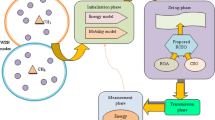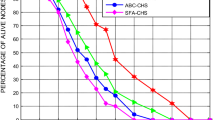Abstract
Wireless Sensor Networks (WSNs) are widely employed for sensing and collecting the data of an environment from a remote area and are used for a variety of engineering applications. The data transfer between the nodes is enabled using the routing protocols that face huge challenge in terms of energy. With energy as an effective constraint, the energy-aware routing is proposed using the optimal cluster head selection procedure. The proposed method of selecting the optimal cluster head is performed using Multi-Objective Taylor Crow Optimization (MOTCO) algorithm that is the combination of the Taylor series and the Crow Search Algorithm (CSA). The proposed objective function is based on the distance between the nodes in the cluster, energy of the nodes, traffic density of the cluster, and the delay in transmitting the data packets. The designed objective function is tuned for a minimum value and the cluster head corresponding to the minimum value of the objective function becomes the optimal cluster head. The simulation is carried out by considering 50 nodes and 100 nodes in the WSN environment for analysis. The analysis proves that the proposed MOTCO outperforms the existing methods by attaining the network energy and throughput at a maximum value of 10% and 65% at the 2000th round.









Similar content being viewed by others
References
Mahajana S, Malhotrab J, Sharmac S (2014) An energy balanced QoS based cluster head selection strategy for WSN. Egyptian Informatics Journal 15(3):189–199
Kumar R, Kumar D (2016) Multi-objective fractional artificial bee colony algorithm to energy aware routing protocol in wireless sensor network. Wirel Netw 22(5):1461–1474
shende D (2018) Automation of dry-wet waste collection to support Swachh Bharat Abhiyan and its monitoring over IOT enabled WSN. Int J ComputSci Eng 6(6):477–479
Omar M, Yahiaoui S, Bouabdallah A (2016) Reliable and energy aware query-driven routing protocol for wireless sensor networks. Ann Telecommun 71(1–2):73–85
Chavan A, Khiani S (2016) Securely energy aware routing in WSN with efficient clustering. In: Proceedings of the 2016 international conference on advanced communication control and computing technologies (ICACCCT). IEEE, Ramanathapuram, pp 624–628
pande NS, Udupi V (2017) Fractional lion optimization for cluster head-based routing protocol in wireless sensor network. Journal of the Franklin Institute 354(11):4457–4480
Purkait R, Tripathi S (2017) Energy aware fuzzy based multi-hop routing protocol using unequal clustering. Wirel Pers Commun 94(3):809–833
Wei G, Ling Y, Guo B, Xiao B, Vasilakos AV (2011) Prediction-based data aggregation in wireless sensor networks: combining grey model and Kalman filter. Comput Commun 34(6):793–802
Haseeb K, Bakar KA, Abdullah AH, Darwish T (2017) Adaptive energy aware cluster-based routing protocol for wireless sensor networks. Wirel Netw 23(6):1953–1966
Chi Y, Chang H (2013) An energy-aware grid-based routing scheme for wireless sensor networks. Telecommun Syst 54(4):405–415
Kang SH, Nguyen T (2012) Distance based thresholds for cluster head selection in wireless sensor networks. IEEE Commun Lett 16(9):1396–1399
Gautam N, Pyun JY (2010) Distance aware intelligent clustering protocol for wireless sensor networks. J Commun Netw 12(2):122–129
Hammoudeh M, Newman R (2015) Adaptive routing in wireless sensor networks: QoS optimisation for enhanced application performance. Information Fusion 22:3–15
Kong L, Pan JS, Snášel V, Tsai PW, Sung T (2018) An energy-aware routing protocol for wireless sensor network based on genetic algorithm. Telecommun Syst 67(3):451–463
Tao M, Yang DLJ (2012) An adaptive energy-aware multi-path routing protocol with load balance for wireless sensor networks. Wirel Pers Commun 63(4):823–846
Arya R, Sharma SC (2018) Energy optimization of energy aware routing protocol and bandwidth assessment for wireless sensor network. Int J Syst Assur Eng Manag 9(3):612–619
Ya L, Pengjun W, Rong L, Huazhong Y, Wei L (2014) Reliable energy-aware routing protocol for heterogeneous WSN based on beaconing. In: Proceedings of the 16th international conference on advanced communication technology. IEEE, Pyeongchang, pp 109–112
Khan NM, Khalid Z, Ahmed G (2009) GRAdient cost establishment (GRACE) for an energy-aware routing in wireless sensor networks. EURASIP J Wirel Commun Netw
Mirzaie M, Mazinani SM (2017) Adaptive MCFL: an adaptive multi-clustering algorithm using fuzzy logic in wireless sensor network. Comput Commun 111:56–67
Fersi G, Jemaa WLMB (2016) CLEVER: cluster-based energy-aware virtual ring routing in randomly deployed wireless sensor networks. Peer-to-Peer Networking and Applications 9(4):640–655
Karlekar NP, Gomathi N (2017) Kronecker product and bat algorithm-based coefficient generation for privacy protection on cloud. Int J Model Simul Sci Comput 8(3):94–107
Ranjan NM, Prasad RS (2018) LFNN: lion fuzzy neural network-based evolutionary model for text classification using context and sense based features. Appl Soft Comput 71:994–1008
Thomas R, Rangachar MJS (2016) Integrating GWTM and BAT algorithm for face recognition in low-resolution images. The Imaging Science Journal 64(8):441–452
Menaga D, Revathi S (2018) Least lion optimisation algorithm (LLOA) based secret key generation for privacy preserving association rule hiding. IET Inf Secur 12(4):332–340
Shankar T, Shanmugavel S, Rajesh A (2016) Hybrid HSA and PSO algorithm for energy efficient cluster head selection in wireless sensor networks. Swarm Evol Comput 30:1–10
Potthuri S, Shankar T, Rajesh A (2018) Lifetime improvement in wireless sensor networks using hybrid differential evolution and simulated annealing (DESA). Ain Shams Eng J 9(4):655–663
Elshrkawey M, Elsherif SM, Wahed ME (2018) An enhancement approach for reducing the energy consumption in wireless sensor networks. Journal of King Saud University – Computer and Information Sciences 30(2):259–267
Kang J, Zhang Y, Nath B (2005) Accurate and energy-efficient congestion level measurement in ad hoc networks. In: IEEE international conference on wireless communications and networking conference. IEEE, New Orleans
Mangai SA, Sankar BR, Alagarsamy K (2014) Taylor series prediction of time series data with error propagated by artificial neural network. Int J Comput Appl 89(1):41–47
Askarzadeh A (2016) A novel meta heuristic method for solving constrained engineering optimization problems: crow search algorithm. Comput Struct 169:1–12
Author information
Authors and Affiliations
Corresponding author
Additional information
Publisher’s Note
Springer Nature remains neutral with regard to jurisdictional claims in published maps and institutional affiliations.
Rights and permissions
About this article
Cite this article
John, J., Rodrigues, P. MOTCO: Multi-objective Taylor Crow Optimization Algorithm for Cluster Head Selection in Energy Aware Wireless Sensor Network. Mobile Netw Appl 24, 1509–1525 (2019). https://doi.org/10.1007/s11036-019-01271-1
Published:
Issue Date:
DOI: https://doi.org/10.1007/s11036-019-01271-1




